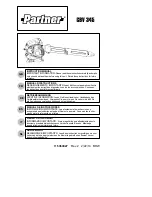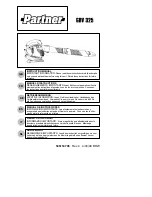
CAUTION:
Always stop engine before changing
de-
flector
position.
Keep
hands away from chute
and
deflector when impeller is operating.
The type and depth of snow will also influence
distance
snow can be thrown.
10.
OPERATING ADJUSTMENTS
CAUTION:
Always stop engine and disconnect spark
plug wire
before
cleaning,
lubricating
or adjusting
your snow thrower.
DRIVE BELT
All
V-Belts
stretch
a certain
amount
during
normal
use. Consequently,
the
snow
thrower
drive
belt
will
probably
require
adjustment
after the first
five hours
of operation.
Belt adjustment
is required
whenever the
primary
clutch
lever drops below the warning
line on
the back plate.
NOTE:
Failure
to adjust
drive
belt
as required
will
result
in excessive
belt wear.
TO TIGHTEN
DRIVE BELT
1. Remove
four
self-tap
screws
(G) and one locknut
(H),
and remove
belt cover (Fig. 19).
FIG. 19
2. Loosen four bolts
(J)
securing
back plate to engine
(Fig. 19).
3. Loosen four engine mounting
bolts at base of engine,
(Fig. 14).
4. Engage
primary
clutch
lever
("IN"
position),
and
move engine toward rear of unit until primary clutch
lever rests approximately
in the centre of slot (above
warning
line).
5. Tighten
engine bolt securely,
making sure rear base
line of engine
is in alignment
with rear of chassis.
6. Check alignment
of five holes in belt cover with four
holes
in back
plate
(G), and bolt
(H). Slide
back
plate
backwards
or forwards
until
hole alignment
is obtained.
Tighten
four
bolts
(J)
securing
back
plate
to engine.
7. Replace
belt
cover
using
four
self-tap
screws
at
(G) and locknut
at (H). Tighten
securely.
SHIFT
CONTROL ROD ADJUSTMENT
The "NEUTRAL"
position
of the snow thrower
trans-
mission
has a wide
range
and,
in some
cases, the
transmission
may remain
in "Forward"
or "Reverse"
position
when the shift
control
rod is moved into the
"Neutral"
range
at the
handle
plate.
This
may not
become
apparent
until
used
in heavy snow.
If this
situation
occurs, stop engine and proceed with the
following
adjustments:
If your
unit
stays
in "Forward"
Drive position
when
shift
control
rod is moved into neutral
range, adjust
flange
nuts at lower end of shift
rod: (Fig. 5 to 8).
(a) Loosen upper flange
nut.
(b) Tighten
lower flange
nut up toward
transmission
control
bracket
one
or two
turns.
This
will,
in
effect,
shorten
the shift control
rod.
(c) Tighten
upper flange
nut down onto transmission
control
bracket.
If your unit stays in "Reverse"
drive when shift control
rod is returned
to neutral
range, adjust flange
nuts on
lower shift
control
rod:
.
(a) Loosen lower flange nut.
(b) Tighten
upper flange
nut down onto transmission
control
bracket
one
or two
turns.
This
will,
in
effect,
lengthen
the shift
control
rod.
(c) Tighten
lower flange
nut up against
transmission
control
bracket.
GROUND CLEARANCE ADJUSTMENT
(Fig. 20)
Slots
in skids
provide
adjustment
up or down. To in-
crease or decrease ground clearance
of impeller
hous-
ing prop
up front
of unit
using a piece of wood or
similar
object and loosen two
Ys
-16 nuts on each skid.
Raise or lower the skids
to desired
height.
In icy or packed
snow conditions,
runners
on skids
FIG. 20
may force the unit to ride on top of snow, preventing
effective
snow
removal.
When
this
occurs,
remove
skids
and invert
them
so that
knife
edges of skids
will cut through
snow.
CHAIN ADJUSTMENTS
(Fig. 21)
Correct chain tension
is of vital
importance
in obtain-
ing efficient
performance.
To obtain
chain tension
as
illustrated
in Fig. 21, each chain
should
be adjusted
by following
the steps below:
3/8'PLAY~
--
-
Summary of Contents for C944.526460
Page 14: ...18 40 50 C ...
Page 16: ......
Page 18: ...CRAFTSMAN 4 CYCLE ENGINE 1 35 I 29 i Il I I I 158 117 158 116 O 58 118 158 82 0 81 ...










































